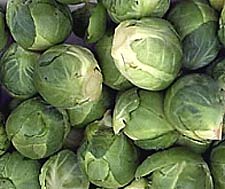Brussels Sprouts - How to Grow, Sow and Cultivate Sprouts
BRUSSELS SPROUTS - VARIETIES TO GROW
Early
Roodnerf
Peer Gynt
Indra
Mid- season
Perfect line
Rollo
King Arthur
Prince Askold
Vremo Inter
Late
Citadel
Sigmund
Bedford Fillbasket
Bastion
BRUSSELS SPROUTS
 Brussels
sprouts are able to provide a good crop from late August until
February if you plant early and late varieties.
Brussels
sprouts are able to provide a good crop from late August until
February if you plant early and late varieties.
You can pick Brussels sprouts from the vegetable garden continually for some time from the same batch.
Brussels sprouts should be sown early as they need a long season of growth - 8 months - to develop well.
Brussel Sprout plants are best first raised in a seed bed then transplanted to a permanent bed for cropping.
PREPARING THE SOIL FOR BRUSSELS SPROUTS
Brussels sprouts prefer ground that has settled firm, so prepare the permanent bed in winter or early spring to give it time to settle thoroughly.
Dig the ground deeply and bury well rotted manure and old compost at about one and a half bucketfuls to the square yard.
Leave the soilrough for the frost and cold wind to act upon it.
In the spring fork it over about 2 inches deep and then follow this by a mix 3 oz of superphosphate with 1 oz of sulphate of potash to the square yard and dress the soil with the mixture before planting out the young Brussels sprouts.
SOWING BRUSSELS SPROUTS
Having prepared the seed bed in a sheltered position sow the Brussels sprouts seed in drills no deeper than 12 mm and 15 cm apart.
To produce early sprouts sow seeds in a cold frame in January or early February.
For picking in late August. Sow thinly into the bed of the cold frame or cloche in drills the same as for the nursery bed .
Thin the Brussel sprouts seedlings to 3 in if rows become to overcrowded. Thinnings can be transplanted if the roots are not damaged.
For normal harvesting sow in the open in February or early March.
Use late late-cropping varieties for the final sowing.
TRANSPLANTING BRUSSELS SPROUTS
Start successional planting out of the young plants the third week in May and continue until the second week of June.
Choose the plants that are about 4 to 6 inches high and about six weeks old –before they become too tall and woody.
Space the plants 3 ft apart and in staggered rows 3ft apart.
Early varieties will be ready for the seed bed in May.
Reject weak plants and do not plant out any Brussels sprouts that do not have a growing point in the centre.
Not only should the ground be firm but the plants should be well firmed in.
If the weather is dry water in well.
INTER-CROPPING BRUSSELS SPROUTS
As the Brussel sprout rows are 3 ft apart another crop can be interplanted - An excellent choice are French beans.
Sow between the rows under cloches around March. Cut down the French beans when the Brussels need the room to a low level, leaving the roots in the ground to provide extra nitrogen for the Brussels sprouts.
TENDING BRUSSELS SPROUTS
If the weather is dry water well and hoe regularly.
After 4-5 weeks draw some soil up around the root stems to give stabilization against the wind.
If growing brussels sprouts in an exposed place stake the plants. When the lower leaves turn yellow break them off.
HARVESTING AND PICKING BRUSSELS SPROUTS
The Sowings of the early varieties should be ready for picking by late August or early September.
The Brussel sprout crop is at its best in November and December, and the late varieties continue into February or March.
The heads of the plants should not be picked until the end of February, as they protect the Sprouts that are forming below and manufacture an elaborated sap which feeds them.
Always cut brussels sprouts off the stem rather than break them off.
Pick when a good size in tight nodules before they become over-blown buds.
At the beginning of the season start at the bottom of the plants and work your way up as the Brussels sprouts mature - pick a few at a time.
When the sprouts have been cut off a secondary crop will be produced at the base of the stem. These will be rather more open sprouts and not as tight as buttons.
You can also cut off the top of the Brussels sprout plant and it can be cooked like greens. This will also encourage the sprouts that are left at the top of the stem to swell up.
WHAT GOES WRONG ?
If you properly cultivate reliable seeds you should get a good Brussels sprout, however if they are not firm and tight it could be a potash deficiency or an excess of nitrogen, poor seeds or soil that is not firm enough.
Of course the birds, caterpillars and aphids can also cause problems.
Grow Brussels Sprouts - how to provide a good crop from late August until February by successional planting of early and late varieties of this green vegetable - preparation of soil and seed bed